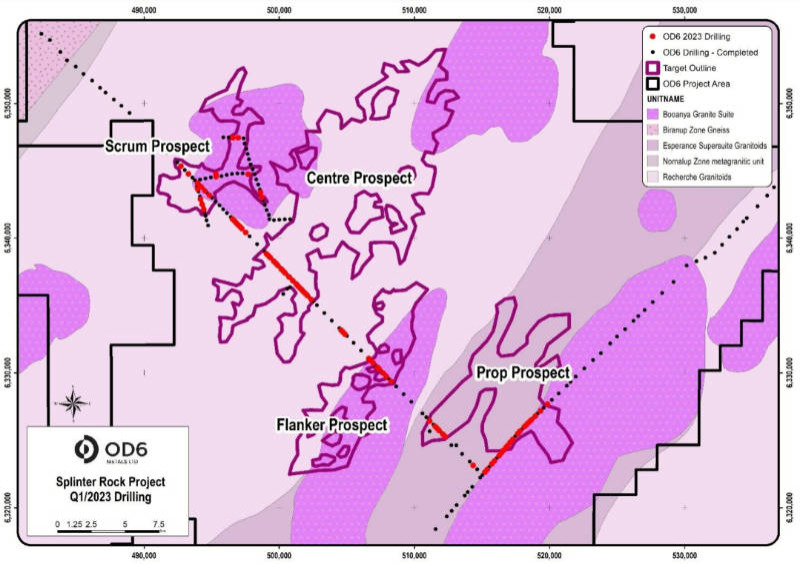OD6’s second round of drilling impresses with thick, bumper REE intercepts

Thick, high-grade REE intercepts are just the beginning of the good news from OD6’s phase two drilling. Pic: via Getty Images
Bumper assays of up to 6,605ppm TREO and clay thicknesses of up to 80m are surefire ways to improve on the already impressive first phase drilling at OD6’s Splinter Rock rare earths project.
And while having both higher grades and larger thicknesses are certainly welcome, there’s more good news from the company’s second phase program of 83 holes.
First up is the very high success rate, with 74 of the 83 holes returning significant REE grades and thickness such as 69m at 1,483 parts per million (ppm) total rare earth oxides (TREO) from 24m and 66m at 1,516ppm TREO – an indication that OD6 Metals (ASX:OD6) has a good handle on where to drill.
This is further supported by the drill results strongly correlating with interpreted data from the airborne electromagnetic survey, which validates both the geological modelling and exploration program design.
Drilling has also confirmed the continuity of REE grade and thicknesses over multiple kilometres of drill lines, a hint that any upcoming resource estimate will be pleasing indeed.
Adding further interest, the drill program has confirmed a new deep channel with a width of 1km and more than 70m of mineralisation at Centre while high-value magnet rare earths represent a significant 22% of the TREO grade.
The drill results follow on recent metallurgical testing by Australian Nuclear Science Organisation, which returned very high metallurgical recoveries of up to 96% MREOs in multiple prospect areas using simple hydrochloric acid leach.
“These exceptional drill results represent some of the highest rare earth grades, over some of the thickest intersections seen in an Australian clay hosted rare earth project,” managing director Brett Hazelden said.
“With thicknesses of 20m to 80m, grades in excess of 1,000ppm Total Rare Earths, and consistency across several kilometres of width, the Splinter Rock project has emerged as a globally significant discovery.
“The areas targeted in this second phase program align with the metallurgical recoveries recently reported, providing validation and further endorsement of the OD6 exploration approach.”
He added that while achieving such results on just one prospect would already be impressive, for all four prospect areas to do so was nothing short of remarkable.
“With such an extensive area of clay REE mineralisation, our next round of drilling will focus on further defining the extent of the Centre and Prop prospects,” he concluded.

Drill results
The Centre prospect is a large clay basin that sits within a tableland area at higher elevations.
It extends for about 5km along a northwest-southeast drill line and is yet to be constrained to the northeast and southwest with AEM modelling suggesting that it may extend as far as 27km beyond the current drill line.
Clay hosted rare earths are located in thick areas of the prospect and vary between 10 to 70m with TREO intersections up to 2029ppm at a 300ppm cut-off grade.
Notable assays from the second phase drill program are:
- 69m at 1,483ppm TREO (21.1% MREO) from 24m (SRAC0227);
- 66m at 1,516ppm TREO (20.2% MREO) from 15m (SRAC0226); and
- 55m at 1,781ppm TREO (23.2% MREO) from 21m (SRAC0218).
Prop resides at the lowest elevation of all prospects and extends 3km to the northwest-southeast and 5km along the northeast-southwest drill lines.
Clay hosted rare earths are located in thick areas of the prospect with the latest drilling returning up to 44m at 821ppm TREO (19.5% MREO) from 18m (SRAC0256).
The Scrum prospect resides on a magnetic high with Booanya granite to the north then heads south to a lower point with low magnetic intensity.
It extends for about 5km along a northwest-southeast drill line and is yet to be constrained to the northeast and southwest.
Phase Two drilling has returned assays such as 60m at 761ppm TREO (25.7% MREO) from 18m (SRAC0274) and 38m at 1013ppm TREO (23.1% MREO) from 21m (SRAC0193).
Last but not least is the Flanker prospect that sits on top of a magnetic high Booanya granite, which is part way up the Ravensthorpe Ramp and is most likely to have some channels of transported clays with a localised weathered granite profile.
Flanker extends for approximately 4km along a northwest-southeast drill line and is yet to be constrained to the northeast and southwest.
Drilling returned a strongest intersection of 43m at 1217ppm TREO (20.5% MREO) from 12m (SRAC0235).
The grades intersected at the prospects are significantly higher than similar clay-hosted REE mineralisation intersected by the company’s peers, which means that there is potential to produce more metal per tonne treated if metallurgical testwork can achieve correspondingly higher REE recoveries.
Recent testing by ANSTO have already provided confidence to proceed with further optimisation test work.
Future activity
OD6 notes that with the successful use of AEM data to guide the second phase drilling, it will now be able to avoid areas of granites and/or minimal clays, enabling it to focus future infill drilling on highly prospective clay zones.
Previous metallurgical results have also indicated that areas of wide clay basins, clay pools and clay channels have higher recoveries, and are likely to represent highly weathered clays with REEs transported by groundwater action.
These data will guide the upcoming Phase 3 drill program of 188 holes totalling 10,000m, which will test the length of the prospects, plus determine the continuity of grade and thickness of the extensions.
This is scheduled to begin later in the current quarter.
This article was developed in collaboration with OD6 Metals, a Stockhead advertiser at the time of publishing.
This article does not constitute financial product advice. You should consider obtaining independent advice before making any financial decisions.
Related Topics

UNLOCK INSIGHTS
Discover the untold stories of emerging ASX stocks.
Daily news and expert analysis, it's free to subscribe.
By proceeding, you confirm you understand that we handle personal information in accordance with our Privacy Policy.








